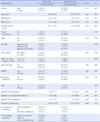Abstract
Purpose
This study was a retrospective survey to examine economic feasibility of home care services for patients with diabetic foot.
Methods
The participants were 33 patients in the home care services (HC) group and 27 in the non-home care services (non-HC) group, all of whom were discharged early after inpatient treatment. Data were collected from medical records. Direct medical costs were calculated using medical fee payment data. Cost-effectiveness ratio was calculated using direct medical costs paid by the patient and the insurer until complete cure of the diabetic foot. Effectiveness was the time required for a complete cure. Direct medical costs included fees for hospitalization, emergency care, home care, ambulatory fees, and hospitalization or ambulatory fees at other medical institutions.
Results
Mean for direct medical costs was 11,118,773 won per person in the HC group, and 16,005,883 won in the non-HC group. The difference between the groups was statistically significant (p=.042). Analysis of the results for cost-effectiveness ratio showed 91,891 won per day in the HC patients, and 109,629 won per day in the non-HC patients.
Figures and Tables
Table 1
Test of Homogeneity of Characteristics between Groups (N=60)

HC=Home Care Services Group; Non-HC=Non-Home Care Services Group; ARB=Antibiotic-Resistant Bacteria; NPWT=Negative Pressure Wound Therapy; EGF=Epidermal Growth Factors; AC=Ambulatory Care.
*Missing data excluded; †Texas university diabetic wound classification system; ‡Multiple responses; §Fisher's exact test; ∥Transforming data by natural log.
References
1. Apelqvist J, Larsson J. What is the most effective way to reduce incidence of amputation in the diabetic foot? Diabetes Metab Res Rev. 2000; 16:S75–S83.
2. Basic statistics diabetes Task Force Team. Basic statistics on diabetes Task Force Team report: Diabetes in Korea 2007. Seoul: Korean Diabetes Association & Health Insurance Review & Assessment Service;2007.
3. Bryant RA, Nix DP, editors. Acute & chronic wounds current management concepts. 3rd ed. St. Louis: Mosby Elsevier;2007.
4. Carter MJ. Cost-effectiveness research in wound care: Definitions, approaches, and limitations. Ostomy Wound Manage. 2010; 56:48–59.
5. Choi GC, Lee HY, Lee SM. A survey of medical costs for health insurance patients in 2008. Seoul: National Health Insurance Corporation;2009.
6. Chung CH, Kim DJ, Kim JY, Kim HY, Kim HY, Min KY, et al. Current status of diabetic foot in Korean patients using national health insurance database. J Korean Diabetes Assoc. 2006; 30:372–376. http://dx.doi.org/10.4093/jkda.2006.30.5.372.
7. Drummond MF, Sculpher MJ, Torrance GW, O'Brien BJ, Stoddart GL. Methods for the economic evaluation of health care programmes. 3rd ed. New York: Oxford university press;2005.
8. Frykberg RG, Zgonis T, Armstrong DG, Driver VR, Giurini JM, Landsman AS, et al. Diabetic foot disorders: A clinical practice guideline (2006 revision). J Foot Ankle Surg. 2006; 45:S1–S66. http://dx.doi.org/10.1016/S1067-2516(07)60001-5.
9. Harris C, Shannon R. An innovative enterostomal therapy nurse model of community wound care delivery. J Wound Ostomy Continence Nurs. 2008; 35:169–183. http://dx.doi.org/10.1097/01.WON.0000313639.37247.c0.
10. Health Insurance Review & Assessment Service. Diseases of frequent home care visiting by year in national health insurance claim database. Home Care Nurses Association;2010. Unpublished internal data.
11. Holzer SE, Camerota A, Martens L, Cuerdon T, Crystal-Peters J, Zagari M. Costs and duration of care for lower extremity ulcers in patients with diabetes. Clin Ther. 1998; 20:169–181.
12. Hwang NM. Cost-benefit analysis of the hospital-based home health care program for terminal cancer patients. Seoul, Korea: Seoul National University;2000. Unpublished doctoral dissertation.
13. Kang SW, Kwon YD, Ko SK, Ji NJ. Effects of home health care on social cost containment: Evidence from the patients undergone by knee arthroplasty in Korea. Korean J Health Econ Policy. 2005; 11:85–99.
14. Kim DI, Kim HC, Ko YJ, Sung IH, Shin BS, Oh WS, et al. Diabetic foot: Diagnosis & treatment. Seoul: Euihakmunhwa;2006.
15. Kim EY, Yang BM. Economic evaluation of long-term care service. Bogeongyeongjeyeongu. 2002; 8:1–17.
16. Kim JH. A cost-effectiveness analysis of long-term home oxygen therapy for patients with chronic obstruction pulmonary diseases (COPD) and policy implication in Korea. Korean J Health Econ Policy. 2005; 11:1–38.
17. Ku BJ, Choi DE, Joeng JO, Rha SY, Lee HJ, Hong WJ, et al. The clinical observation in diabetic patients with foot ulcer. Diabetes Monit. 2002; 3:244–252.
18. Lavery LA, Armstrong DG, Harkless LB. Classification of diabetic foot wounds. J Foot Ankle Surg. 1996; 35:528–531. http://dx.doi.org/10.1016/S1067-2516(96)80125-6.
19. Lee TW. The costs of long-term care alternatives for the elderly. J Korean Acad Nurs Adm. 1998; 4:351–361.
20. Lee T. Methodological issues in nursing research on cost-effectiveness analysis. J Korean Acad Nurs. 2001; 31:1202–1209.
21. Lim JY. Cost-effectiveness analysis of home care service for cerebrovascular disease patients. Seoul: Korea University;2001. Unpublished doctoral dissertation.
22. Ministry of Health and Welfare. Guide on the medical institute base home health agency management. Seoul: Yimungieob;2010.
23. Nathwani D, Zambrowski JJ. Advisory group on home based and outpatient care (AdHOC): An international consensus statement on non-inpatient parental therapy. Clin Microbiol Infect. 2000; 6:464–476. http://dx.doi.org/10.1046/j.1469-0691.2000.00113.x.
24. Park JY, Ko SK. Cost-benefit analysis of the community-based home health care program. Bogeongyeongjeyeongu. 2000; 6:203–245.
25. Paul IM, Phillips TA, Widome MD, Hollenbeak CS. Cost-effectiveness of postnatal home nursing visits for prevention of hospital care for jaundice and dehydration. Pediatrics. 2004; 114:1015–1022. http://dx.doi.org/10.1542/peds.2003-0766-L.
26. Song CR, Han SH, Lee YA, Kim MY, Chae SM. An analysis of treatment types and home care services referral for patients with diabetic foot. J Korean Acad Soc Home Care Nurs. 2011; 18:32–39.
27. Stockl K, Tafesse E, Vanderplas A, Chang E. Cost of lower-extremity ulcers among patients with diabetes. Diabetes Care. 2004; 27:2129–2134. http://dx.doi.org/10.2337/diacare.27.9.2129.
28. Sung YH, Hwang MS, Ru SS, Kim SJ. The effects of hospital based home care nursing on antibiotic treatment for patients with CMV infection following kidney transplant. Clin Nurs Res. 2005; 10:129–144.
29. Ragnarson Tennvall G, Apelqvist J. Health-economic consequences of diabetic foot lesions. Clin Infect Dis. 2004; 39:S132–S139. http://dx.doi.org/10.1086/383275.
30. Yang BM. Health economics. 2nd ed. Seoul: Nanam Press;2009.




 PDF
PDF ePub
ePub Citation
Citation Print
Print







 XML Download
XML Download